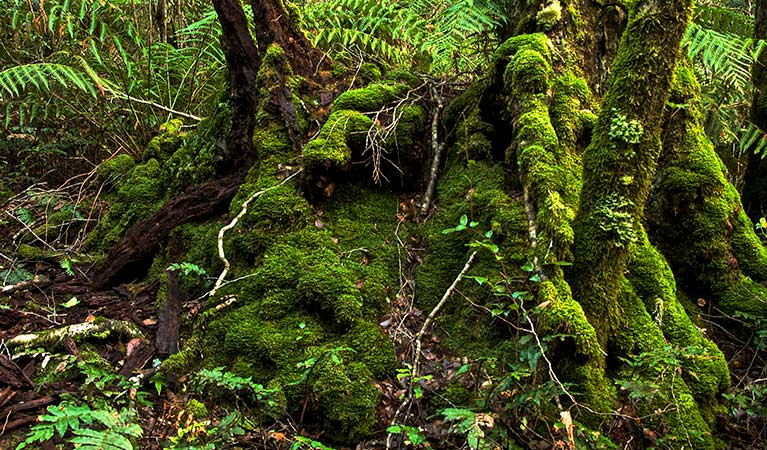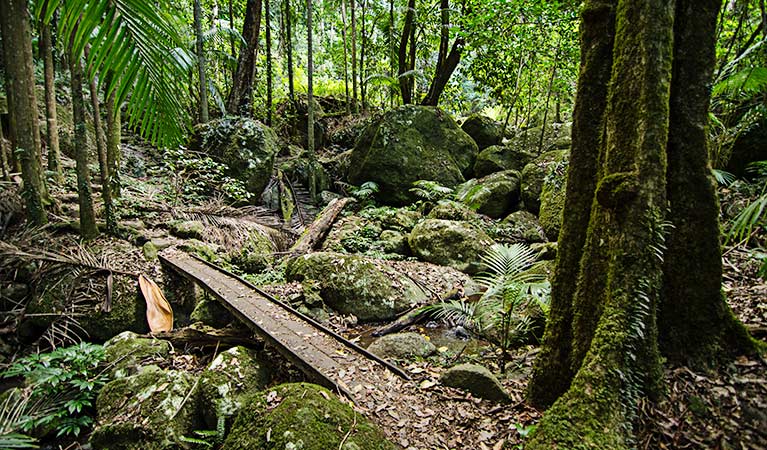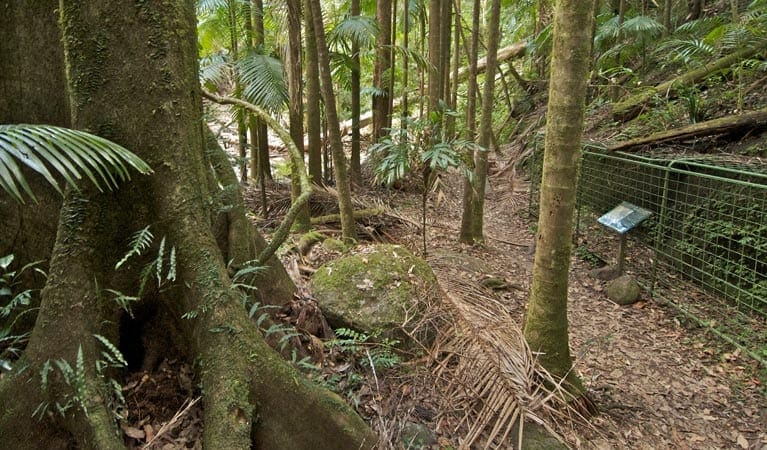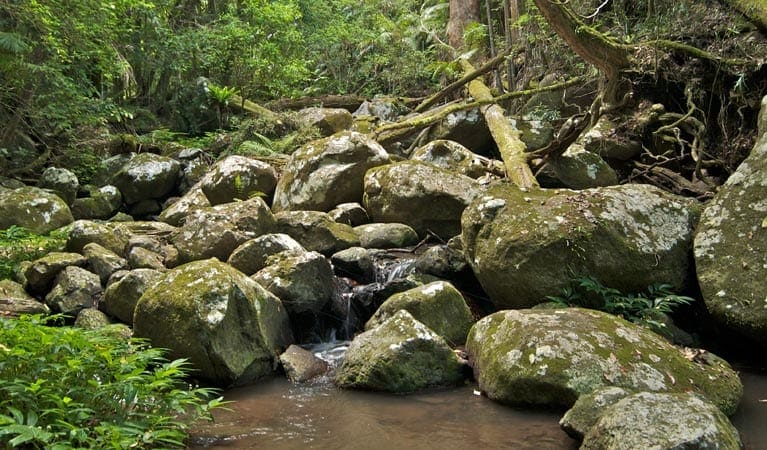Hike at a Glance
Max elevation: 0m
Min elevation: 0m
Total Ascent: 0m
Hike overview
Helmholtzia loop walking track takes you on a short, easy walk through a beautiful section of Border Ranges National Park. It takes you across pristine Brindle Creek on low bridges and into World Heritage rainforest.
The name of this track comes from the helmholtzia plant that grows in the area. Also referred to as the stream lily, this rare plant is found only in the rainforest of north-east NSW and south-east Queensland. Helmholtzia are large strap-leafed plants which require a reliable water supply and are usually found along the banks of creeks and in gullies.
Helmholtzia loop walking track is also home to hoop pines, stands of Antarctic beech and abundant epiphytes - a plant that grows on another without being a parasite, while sourcing moisture and nutrients from the atmosphere and nearby debris.
Be sure to bring your binoculars along for a spot of birdwatching and keep your eyes and ears out for some endangered frog species including Fleay's barred frog and pouched frog.
Take a virtual tour of Helmholtzia loop walking track captured with Google Street View Trekker.
Tips
It's a good idea to fill your fuel tank before heading out to the park as the closest service stations are Kyogle, Woodenbong, Nimbin and Rathdowney.
The weather in the area can be extreme and unpredictable, so please ensure you're well-prepared for your visit.
Remember to take your binoculars if you want to go birdwatching
Visit NSW National Parks and Wildlife Service for more information on this trail.
The longitude and latitude of the start and end points are approximately only and should not be used for navigation purposes. Please contact me if you know the correct coordinates.
Gallery
Got some great shots from this hike? Upload your photos here to inspire others and show off the beauty of the trail!
Click to view form >>
Submitting your photos doesn’t mean you lose ownership. You can be credited for your contributions, and you can request removal at any time.
Content use
Please don’t copy GPX files or content from this site to AllTrails or other platforms. Each trail has been personally mapped, documented, and refined to support Australia’s bushwalking and hiking community. While some details come from land managers, every listing reflects significant personal effort. This is a free, community-driven initiative—your respect helps keep it that way.
Walk map and GPX file
It looks like I don’t have a GPX file for this trail yet. If you have one to share, please email it to me! I’ll verify it against official maps before adding it to help other hikers have a safer, easier experience. Thanks for contributing to a better hiking resource.
Getting there
Getting to the trailhead: Border Ranges National Park.
Helmholtzia loop walking track is in the eastern precinct of Border Ranges National Park. To get there:From Murwillumbah:Travel south-west on Kyogle Road to Lillian Rock, then turn right onto Williams Road.Travel along Williams Road for 2.5km, then Creegans Road for 6km, until you reach the park boundary.From the boundary, continue 26km along Tweed Range Scenic Drive to Brindle Creek Road intersection, then turn right.Travel 2km to Brindle Creek carparkFrom Kyogle:Travel north along Summerland Way for 14km until you reach WiangareeTurn right at Wiangaree into Lynches Creek Road and travel east for 12km to Forest RoadTurn right onto Forest Road and continue 4.5km to the park boundaryFrom the boundary, continue on Tweed Range Scenic Drive for 6.5km and then turn left onto Bridle Creek Road.Travel 2km to Brindle Creek carpark Parking Parking is available at Brindle Creek carpark.
Closest towns to this walk: Bonalbo, Kyogle, Lismore, Mount Warning, Murwillumbah, Nimbin, Rathdowney, Richmond Range, Stokers Siding, Tumbulgum, Uki, Woodenbong
About the region
Border Ranges National Park in the North Coast region
Border Ranges National Park is always open but may have to close at times due to poor weather or fire danger.
Similar walks nearby
Looking for more walks in or near Border Ranges National Park? Try these trails with a similar difficulty grade.
Track grade
Grade 3 (Moderate) - Walks for Most Fitness Levels: Grade 3 on the AWTGS represents moderate walking tracks. These are ideal for walkers with some fitness who are comfortable with some hills and uneven terrain. While suitable for most ages, some bushwalking experience is recommended to ensure a safe and enjoyable experience. Tracks may have short, steep hill sections, a rough surface, and many steps. The total distance of a Grade 3 walk can be up to 20 kilometers.
Explore safe
Plan ahead and hike safely! Carry enough water, pack layers for changing conditions, and bring safety gear like a torch, PLB, and reliable communication device. Check official sources for trail updates, closures, and access requirements, and review local weather and bushfire advice. Most importantly, share your plans with someone before you go. Being prepared makes for a safer and more enjoyable hike! Stay Safe, Explore More, and Always #ExploreSafe.
Packing checklists
What you carry in your pack depends on factors like weather, terrain, and your adventure type. Not sure what to bring? My free planning, food, and packing checklists are a great starting point, covering day hikes, overnight trips, and multi-day adventures. Use them to customise your kit and always prioritise safety.
Let someone know
Before heading out, take a moment to fill out your trip intentions form. It’s a quick way to share your hike details with family or friends. If something goes wrong, they can notify emergency services, ensuring a faster response and peace of mind. Stay safe and enjoy your adventure
Suggest an edit
Spotted a change on this trail? Maybe there are new features, the route has shifted, or the trail is permanently closed. Whatever the update, I’d love your input. Your feedback helps fellow hikers stay informed and ensures that our trail info stays fresh and reliable.
Acknowledgement of Country
Trail Hiking Australia acknowledges the Traditional Owners of the lands on which we hike and pay respects to their Elders, past and present, and we acknowledge the First Nations people of other communities who may be here today.






